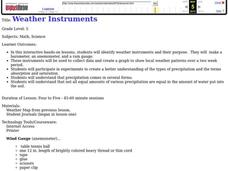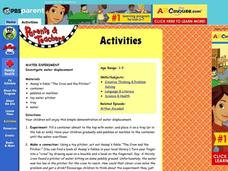Curated OER
Introduction to Nutrition
Fourth graders take a closer look at the foods they eat and the nutritional value of each. This lesson helps them see why foods are grouped together the way they are and what types of nutrition are provided by these food groups. They...
Curated OER
The Food Pyramid
Learning about nutrition and how to eat healthy foods is very important for kids these days. Here is a lesson, designed for 4th graders, that teaches these important skills. Pupils plan nutritional meals by using the USDA's Food Guide...
Curated OER
What Flies?
Young learners consider what flies and what kinds of sounds airplanes, animals, etc. make when they fly. They also get to generate a brainstorm list. Children discuss what the categories should be once the list is completed. Some really...
Curated OER
Culture Commotion
Exposing young children to the wonders of world cultures is very important. Here is a sweet lesson which does just that! In it, learners listen to music, and stories from cultures around the world. They learn greetings in different...
Curated OER
Waves
Light waves and sound waves are the focus of this science lesson designed for 5th graders. Besides discovering how these waves travel, learners also discover the basic properties of waves, and analyze data tables and graphs. The...
Curated OER
The Game is Afoot - A Study of Sherlock Holmes
Mystery is an exciting genre for young readers to investigate. The plots are so intriguing! Here is a series of lessons featuring Sherlock Holmes stories that invite learners to enter the world of the mystery genre. Based on what they...
Curated OER
Metamorphic Magic!
Students explore the steps involved in the formation of metamorphic rock as they prepare a cookie receipe. As part of the process, sedimentary rocks are created and changed through heat to a metamorphic cookie.
Curated OER
Magnet Mania
Youngsters go on a magnetic fishing trip! Use an engaging and clever language arts lesson to reinforce the recognition of the letters of the alphabet with very young readers. A fishing pole is made of a ruler and a piece of string with a...
Curated OER
Money Math
Is there a better, and more motivating, math manipulative than money? Kids love to use it, and it's a great teaching tool. Here, there are three good activities using coins. Learners create patterns, sort change, and have a...
Curated OER
Bubbles Galore
Students investigate bubbles. In this science lesson, students observe how long bubbles last and graph the results of the experiment.
Curated OER
Button Math
Use buttons, cards, and dice to perform simple math problems! This inventive lesson should be quite engaging for young learners. Kindergarteners use buttons to help them understand the concepts of greater than, less than, and equal to.
Curated OER
Does The Type of Mulch Used Affect Plant Growth?
Students measure, record and graph the plants they grow in a controlled setting. They feed and water the plants as needed and use the scientific method to evaluate the growth.
Curated OER
Overflowing the Banks
Students discover how levees hold a river within its banks and cause height of river to rise & back up into less well-protected tributaries that feed into the river, by constructing model of riverbanks, creating a flood, &...
Curated OER
Teaching About Tolerance Through Music
Explore the importance of tolerance with a music-themed lesson. Learners listen to the music of Peter, Paul, and Mary, and discern the underlying messages before discussing the painful effects of ridicule, disrespect, and bullying.
Curated OER
Your Five Senses
Students identify the five senses. For this biology lesson, students participate in an experiment and use their five senses to identify various substances.
Curated OER
Weather instruments
Students explore weather instruments. In this weather lesson, students make rain gauges, anemometers, and barometers following the instructions given in the lesson. Students set up a weather station using their instruments and record and...
Curated OER
Balls & Hoops : Fun with Balls and Tubes
Young scholars race to keep these balls rolling. In this early childhood physical education lesson, students experiment with cause and effect as they work with different heights of cardboard tubes.
Curated OER
Boxes & Blocks: Tunnel Vision
Young scholars paint, create, and crawl through their own tunnel. In this early childhood visual arts lesson, students will develop gross motor skills and engage in activities that promote physical exercise as they create and explore...
Curated OER
Boxes & Blocks: Puffer Bellies and Box Cars
Students turn cardboard boxes into outdoor dramatic play. In this early childhood visual arts lesson, students explore cooperative and dramatic play outdoors by challenging children to create a train from cardboard boxes.
Curated OER
Sort It Out
Elementary schoolers engage in a game of logical reasoning called Secret Sort. A Venn diagram is used as a way to sort objects. This resource would be a great way to introduce the Venn diagram (maybe the most famous, and most-useful...
Curated OER
Making Music
Budding musicians engage in an exciting lesson which has them make musical instruments out of ordinary household items. By using paper plates, plastic cups, rubber bands, storage containers, and wooden spoons they make a variety of...
Curated OER
Water Experiment
Here is a great lesson designed for very young scientists. In it, they act out the famous Aesops fable, "The Crow and the Pitcher." In doing this, they get to experience water displacement first-hand. Some terrific extension activities...
Curated OER
Thumbprints
Thumbprints are fascinating! Here is a clever lesson that allows kids to discover that everyone has a unique thumbprint - no two are alike! They use magnifying glasses to closely observe their own, and someone else's thumbprints. Then,...
Curated OER
Skate Borders
Elementary schoolers explore how making different rectangular shapes with the same perimeter has an affect on the area of those shapes. Learners use the worksheet embedded in the plan to design their own skateboarding track. They use...

























